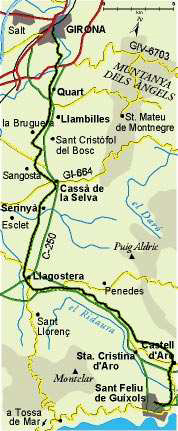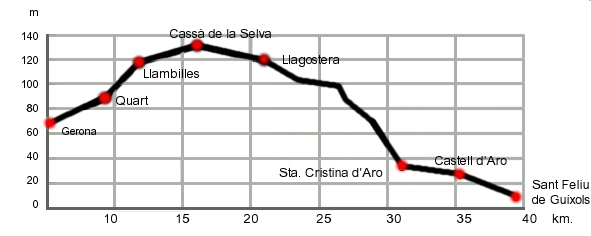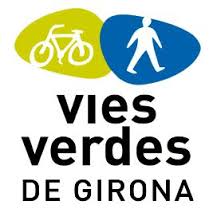Technique
Technical specifications
|
The route had 82 curves, 38 leading to the right and 44 to the left. The route actually had a 36% curve rate, meaning that the 36% of the time, one would be running on curves. The track was a Vignole type having 16 Kg/m, with 7,60 meter bars, and it was bought on Caramin & Cie on Belgium With the years the track received small damage once in a while, being repaired on a very singular way. The most degraded tracks went throught the secondary lanes of the station. There were 62 total road switches, being Gerona with 11 and Sant Feliu with 19, the ones with the more switches on them. The tracks had wooden boards, and it only had different kinds on the curves that had the least radius, that meaning that the frequency in which they put the boards would depend on the shape of the curve. A closest curve would have far more board frequency than flat routes.
El balasto normalmente era de tierra. The route had ramps under 10 mil. mark (14%), 15 mil. (11% of the total route) and a 5% that were superior to 15 mil. The strongest ramp would be the one that connected the Qaurt station with Llambilles one, and it was near the 19 mil. Electronic signals or simple ones were nearly non-existant in this route. The Gerona station had the most avanced train controller signal, leaving the other stations with a slightly least advanced train controlling signals. The kilometric signals were done with preselected stones trhat had 20 cm in width and 15 cm in hectometrical measure. Los números eran el doble de grande en la primera. The harbor branch was a very important point. It had a 25 mil. ramp and it used thicker rails (21 kg/m) so it supported the new operative diesel locomotives, with them being used to launch the convoys from the Sant Feliu station to the harbor.
It had two stations of first class, two of second class, four of third class, five halts and port facilities.
Due to it being an economical railroad, its route had barely 5 significant bridges and no tunnels to help avoid expensive operations and buildings.
Track Track profiles, configuration and switches.
Timetables service boards and combinations with the M.Z.A. main convoy.
Total passengers, harbor transit and total comercial transit.
Total budget, benefits of the explotation, corresponding divisions and official government helping.
The company organized graphic, working conditions and working organizations.
Rules and projects, and additional documentation coming in books to help its organization.
Gathering of books and adds regarding the total SFG route, or even small portions of it. |
If you have information that may be interesting from a historical point of view and you can leave me, please send an email and we sill contact you. This site has no commercial interest.





